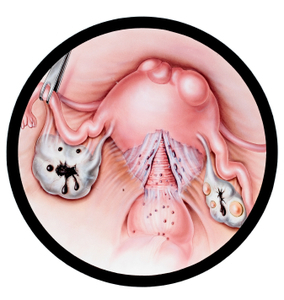I have a horrible disease called endometriosis. It has completely destroyed my life in every way possible. I am 29 and going through menopause with no children and no chance of having my own children. My body is full of scars from multiple failed surgeries and from unbalanced hormones.
Endometriosis has caused me to feel like less of a woman and has made feel extremely insecure. It has taken all of my energy to focus on getting through the pain, rather than taking the time to enjoy life and figuring out who I am besides a woman with endometriosis. I have not been able to lead a normal life due to the extreme chronic fatigue and daily unbearable pain I have suffered since the age of 15.
Several Years of Misdiagnosis
At 15 I was misdiagnosed with irritable bowel syndrome (IBS), which complicated my chances of receiving an early proper diagnosis of my endometriosis. It started out with heavy painful periods, accompanied by washroom issues that kept me from school a couple days to a week at times. It then escalated to stabbing, throbbing pains in my abdomen as well as a crushing pressure type of pain in my legs on a daily basis that would just drop me to my knees and render me incapacitated. The pain was so bad that just putting on and wearing clothes was painful. Just the slightest touch or brush of clothing or anything to my abdomen would increase the pain level.
I had several visits to the hospital due to immense pain that ended in the dispensing of unnecessary prescriptions related to IBS. I was not given the proper examinations or tests to determine my actual underlying problem. It was not until I was 18 and another regular visit to the hospital that they finally believed there was something else that was causing my pain. They had figured I was 5 months pregnant due to an extremely distended abdomen. Despite telling them it wasn’t possible because I had not been sexually active, they still gave me a pregnancy test, which did indeed come back negative. An emergency ultrasound showed an endometrioma cyst that was almost 9 inches in diameter containing blood on my right side and a 2 inch cyst on the left side. I had emergency surgery in which the larger cyst, my right ovary and tube were removed immediately.
Finally, a Diagnosis
I was diagnosed with stage 4 endometriosis. One of my many doctors had assumed that the endometriosis had been growing since puberty at the age of 9. Other doctors believe I could have been born with it. Once diagnosed, I went through every type of medical and alternative treatment, as well as failed surgeries, and failed cyst drainings.
My endometriosis kept coming back and started to cause even more damage. I ended up with another very large cyst on my left side. The cyst had become so large that it had physically pushed some of my organs out of place and had begun to crush others. I also had adhesions–web like tissue that had begun to bind my organs together and to the cyst.
Trying to Find Effective Care
I went through several doctors, who in the end had done all they could for me. They told me that they were not skilled enough to deal with my case, and so I was passed on to the end of the line in my city, which was cancer care. They offered me a hysterectomy and removal of my last ovary, but not removal of all of my endometriosis, because they told me that was impossible to do. They told me that this surgery probably wouldn’t help, they said it was the only option I had left.
It was around this time that a friend and I had decided to start a support group because we felt so alone and frustrated with the lack of options and awareness in our province (Manitoba, Canada). We found out that there was a surgical method called excision that if done properly can remove most if not all of the disease and have little to no recurrence. This type of surgery was not offered by any surgeon in Manitoba.
Excision Surgery in Mexico
I decided to look into these specialists around the world. I ended up speaking with some in Canada, the U.S., and Mexico. I had been approved by Manitoba health insurance to see a specialist outside of Manitoba because of the severity of my disease. However, the wait was too long so I ended up going to Mexico instead. I had a 6 and a half hour excision surgery which resulted in the removal of my last ovary, but I did not need a hysterectomy and was able to keep my uterus. I have been pain free for almost a year now, but I am now dealing with the effects of surgical menopause at the age of 29. Even though the pain is gone I will constantly live with the damage that endometriosis has left me with.
Facilitating Support, Education and Awareness
I have been dealing with endometriosis symptoms and its effects for more than 11 years. It wasn’t until a few years before my last surgery that I was able to form a strong support system. Knowing what it felt like to go through most of my journey misunderstood, alone and confused, I have vowed to spend as much time as possible spreading awareness, education, and bringing women together so that no one has to go through what I did alone. I started an endometriosis support group in Manitoba with a friend of mine called W.O.M.E.N (Women of Manitoba Endometriosis Network). Recently we have also come together with The Endometriosis Network Canada to have our very first awareness day in Winnipeg on May 7, along with 16 other cities across Canada.
From what doctors have told me, had I been diagnosed earlier and had the proper excision surgery I probably would have been able to have children, and would not have had to go through so much suffering and unnecessary treatments. The pain of the disease may be gone for me but I will never be able to forget what is has done and taken away from me.









